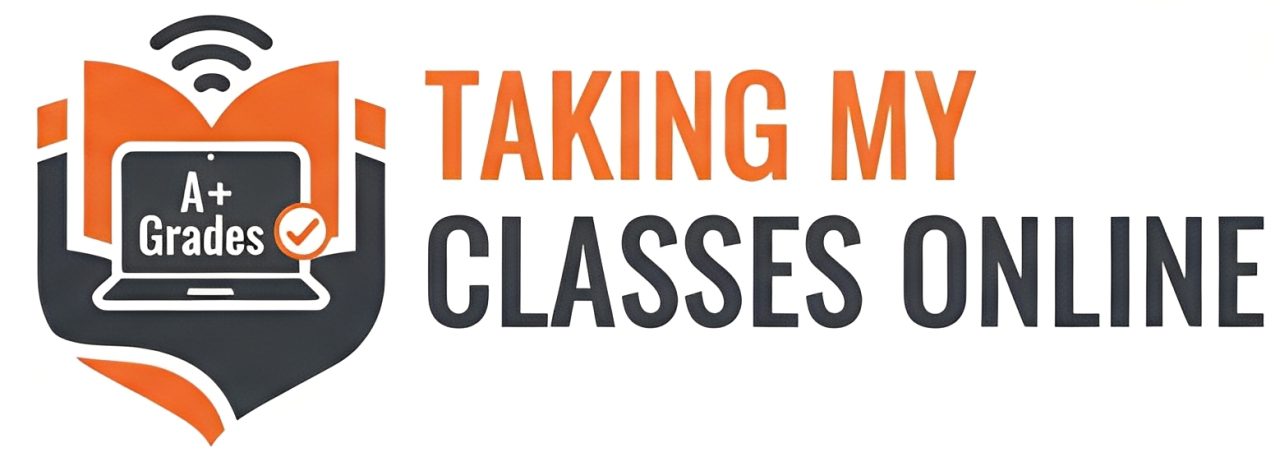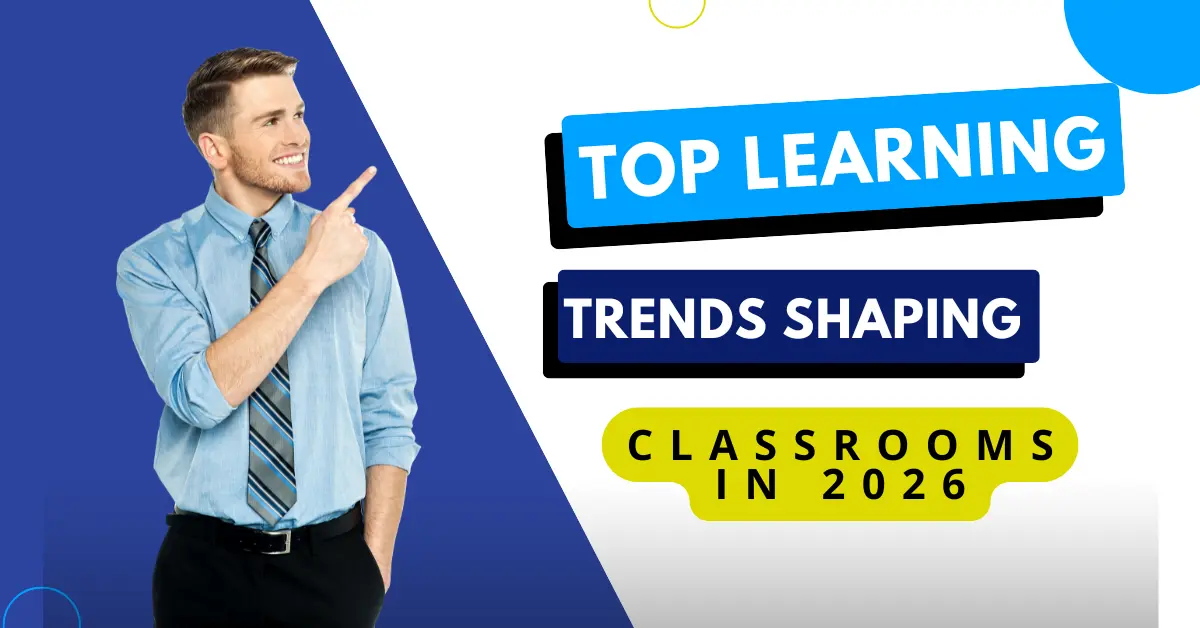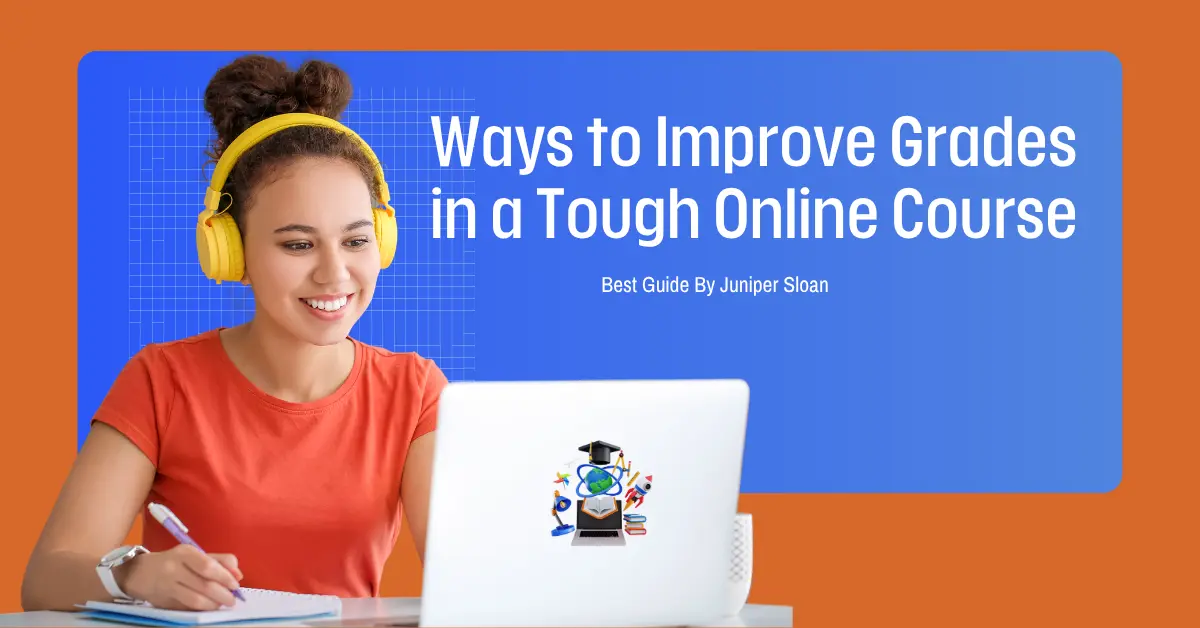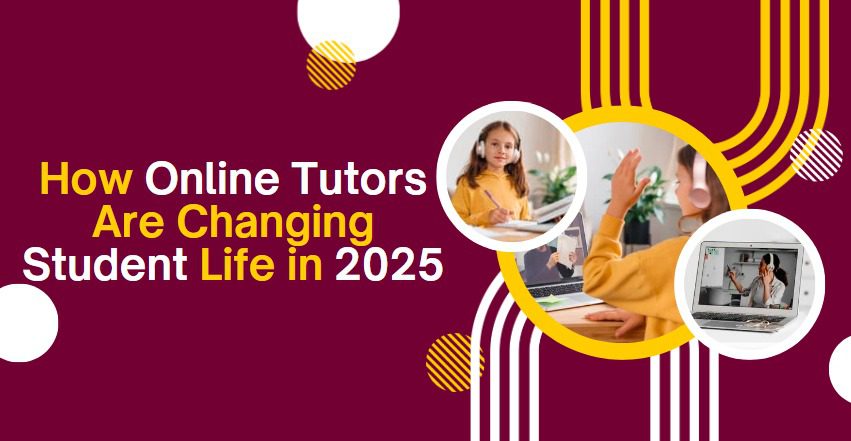The year 2026 marks a defining shift in how students learn and how teachers teach. As someone who has worked closely with online learners for years, I’ve seen first-hand how digital transformation has turned classrooms into vibrant spaces of creativity, connection, and collaboration. At TakingMyClassesOnline.com, we help students experience this change daily, and I can tell you that the future of education is more interactive, adaptive, and personalized than ever before.
In this blog, I’ll share the most important learning trends that are shaping classrooms in 2026. Whether you’re a student, educator, or parent, you’ll discover how these modern teaching methods are making learning more engaging and effective across the world.
- 1. The Rise of Digital Learning
- 2. Blended Learning: The Best of Both Worlds
- 3. Hybrid Classrooms are Here to Stay
- 4. Personalized Learning: One Size No Longer Fits All
- 5. Adaptive Learning Systems Changing the Game
- 6. Virtual and Augmented Reality in Classrooms
- 7. Gamified Learning Makes Education Fun
- 8. Student-centered Teaching Takes the Lead
- 9. Modern Teaching Methods Redefining Education
- 10. The Future of Education in 2026
- 11. Interactive Learning Environments for Better Engagement
- 12. Technology-Driven Classrooms: Smart, Seamless, and Sustainable
- 13. Role of Artificial Intelligence in Teaching
- 14. Data-Driven Education for Smarter Decisions
- 15. Collaborative Classroom Tools Empowering Teamwork
- 16. Virtual Classrooms and E-Learning: The New Standard
- 17. Smart Classroom Technologies and Automation
1. The Rise of Digital Learning
Digital learning is no longer an alternative; it’s the new normal. Classrooms today blend online and in-person experiences to create flexible and inclusive education for all.
Students use digital platforms to attend live lectures, collaborate on group projects, and access study materials anytime. This shift enables personalized pacing, allowing fast learners to progress quickly while giving others time to review and understand complex topics.
Based on my experience helping thousands of students manage online coursework, I’ve seen how digital learning increases accessibility. It allows learners in remote areas to connect with qualified educators without physical barriers. Moreover, the integration of cloud-based platforms ensures that assignments, notes, and communication stay organized and available 24/7.
Why It Matters
Digital learning supports global connectivity. Students from different countries can now study together, exchange ideas, and develop cultural understanding. It’s not just about technology; it’s about making quality education available to everyone.
2. Blended Learning: The Best of Both Worlds
Blended learning combines traditional face-to-face teaching with online elements. This mix helps students enjoy the structure of physical classes while benefiting from digital tools.
For example, a student might attend a science lecture in person and then complete an online simulation that reinforces the same concept. This integration strengthens understanding and keeps learning dynamic.
From my work with students across the USA, I’ve noticed that blended learning improves engagement. When lessons mix visual, auditory, and interactive elements, students retain knowledge longer.
Key Benefits of Blended Learning
- Improved flexibility and time management
- Interactive learning through multimedia content
- Continuous performance tracking and feedback
- Stronger student-teacher collaboration
The flexibility of blended learning makes it ideal for working students or those balancing multiple responsibilities. It represents a classroom model that adapts to real life.
3. Hybrid Classrooms are Here to Stay
Hybrid classrooms are one of the biggest learning trends of 2026. These environments merge physical and virtual participation in real time. A student sitting at home can attend the same class as peers sitting in the school auditorium.
Hybrid models ensure inclusivity. They reduce absenteeism and make learning accessible for those who cannot attend in person. For many of my clients at TakingMyClassesOnline.com, hybrid setups have been life-changing — especially for learners juggling part-time jobs or family duties.
Why Students Love Hybrid Learning
Hybrid classrooms offer choice. Students can decide how they learn best — online or on-campus. This autonomy increases motivation and ownership of their education.
4. Personalized Learning: One Size No Longer Fits All
Every student learns differently. Personalized learning ensures each learner gets a custom plan based on their strengths, pace, and goals.
In 2026, data-driven tools analyze student behavior and create tailored learning paths. If a student struggles with math but excels in writing, the system adjusts lessons to improve weak areas while challenging strong ones.
At TakingMyClassesOnline.com, we often help students create study plans aligned with their unique pace and understanding. This personalized approach not only boosts confidence but also leads to higher academic success rates.
How Personalized Learning Works
- Tracks student performance using analytics
- Suggests resources that match individual needs
- Encourages self-paced learning
- Uses AI tutors for guidance and instant support
When learning feels personal, students engage more deeply and stay motivated to reach their goals.
5. Adaptive Learning Systems Changing the Game
Adaptive learning systems take personalization even further. These AI-powered tools analyze real-time data and adjust the content based on the learner’s performance.
For instance, if a student answers a quiz question incorrectly, the platform automatically provides a simpler explanation before moving ahead. This instant adjustment ensures students master each concept fully.
I’ve seen adaptive learning make a real difference for struggling learners. It provides feedback, identifies gaps, and supports steady progress — all while keeping the experience fun and engaging.
Benefits of Adaptive Learning
- Real-time feedback and content adjustment
- Improved accuracy in learning outcomes
- Reduced frustration and drop-out rates
- Increased learner confidence and mastery
Adaptive systems are the bridge between technology and human understanding. They give teachers valuable insights to help students more effectively.
6. Virtual and Augmented Reality in Classrooms
Imagine exploring the solar system without leaving your chair or walking through a virtual ancient city to study history. That’s exactly what virtual and augmented reality (VR/AR) make possible in 2026.
VR and AR create immersive environments that transform how students learn complex subjects. Science experiments, medical simulations, and 3D visualizations are now part of everyday education.
For example, a biology student can use AR glasses to dissect a virtual frog. This makes learning engaging while keeping it safe and cost-effective.
Why VR and AR Matter
- Turn theoretical concepts into practical experiences
- Build engagement through interactive visuals
- Help students retain information longer
- Encourage creativity and problem-solving
In short, virtual and augmented reality in classrooms make learning a multisensory adventure, helping students connect with subjects at a deeper level.
7. Gamified Learning Makes Education Fun
Gamified learning uses game elements, points, badges, levels, and rewards — to boost motivation. It taps into our natural desire for achievement and competition.
In 2026, many schools and online platforms use gamification to make subjects exciting. Students earn rewards for completing quizzes, unlocking lessons, or helping peers.
I’ve observed how gamified learning keeps students active and reduces boredom. Instead of dreading homework, they treat it as a challenge.
Advantages of Gamified Learning
- Encourages active participation
- Improves focus and memory retention
- Builds problem-solving and teamwork skills
- Adds excitement to routine lessons
Gamified learning isn’t just about fun; it’s about creating curiosity and making education enjoyable again.
8. Student-centered Teaching Takes the Lead
Traditional classrooms placed teachers at the center. In 2026, the spotlight has shifted — students now take control of their learning journey.
Student-center teaching encourages collaboration, discussion, and critical thinking. Teachers act as mentors rather than lecturers, guiding students to discover answers themselves.
At TakingMyClassesOnline.com, we value this shift because it aligns perfectly with modern learners’ needs. Students today don’t just memorize facts; they apply knowledge creatively and practically.
Core Principles of Student-Centre Learning
- Promotes active learning and engagement
- Fosters communication and teamwork
- Encourages self-reflection and accountability
- Builds long-term learning habits
This approach creates confident learners who can adapt to changing academic and professional demands.
9. Modern Teaching Methods Redefining Education
In 2026, teachers are adopting modern teaching methods that focus on engagement, creativity, and critical thinking. Techniques such as flipped classrooms, project-based learning, and microlearning have become common across schools and universities.
Flipped classrooms let students learn basic concepts online before attending live sessions for discussion and application. This makes classroom time more productive.
Project-based learning connects lessons with real-world problems, encouraging teamwork and innovation.
Based on my interactions with educators, these methods help students develop practical skills needed for the modern workplace — not just academic knowledge.
10. The Future of Education in 2026
The future of education in 2026 revolves around adaptability and inclusivity. Education systems now value emotional intelligence, creativity, and collaboration as much as grades.
Technology is no longer just a tool; it’s part of the learning culture. Schools and universities use data-driven insights to improve teaching outcomes, making education more relevant to today’s challenges.
Key Features of Future Education
- Integration of smart classroom technologies
- Real-time performance tracking
- Global learning opportunities
- Focus on mental health and well-being
Education in 2026 prepares students not only to succeed academically but also to think critically and act responsibly in society.
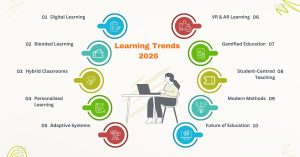
11. Interactive Learning Environments for Better Engagement
Modern classrooms are built for interaction. Whether virtual or physical, these environments promote collaboration and creativity.
Interactive tools like digital whiteboards, polls, quizzes, and discussion forums help students share ideas easily. Teachers use analytics to track engagement and adjust their strategies accordingly.
Interactive learning environments also create a sense of community. Students feel connected even in online settings, which reduces isolation and improves participation.
Impact of Interactivity
- Strengthens communication
- Builds teamwork skills
- Increases focus and participation
- Makes lessons memorable
By combining technology with creativity, interactive learning turns classrooms into active learning spaces.
12. Technology-Driven Classrooms: Smart, Seamless, and Sustainable
Technology-driven classrooms are shaping how students learn in real-time. From smart boards and AI tutors to voice-activated systems, technology has simplified communication and improved efficiency.
Teachers can instantly share materials, monitor attendance, and evaluate performance through digital dashboards. This automation allows more time for meaningful teaching rather than administrative work.
At TakingMyClassesOnline.com, we’ve adopted similar tools to manage online classes efficiently. The result is faster communication, better feedback, and improved learning outcomes.
Top Smart Classroom Technologies in 2026
- AI teaching assistants
- Interactive projectors
- Smart attendance systems
- Voice-based learning platforms
These innovations not only save time but also make education more engaging and sustainable.
13. Role of Artificial Intelligence in Teaching
Artificial intelligence is revolutionizing how lessons are delivered. AI assists in lesson planning, grading, and student feedback.
Teachers use AI-driven insights to understand each learner’s strengths and weaknesses. This ensures no student is left behind.
From chatbots answering questions to AI tutors providing extra help, the role of artificial intelligence in teaching has become indispensable.
AI Benefits in Education
- Automates repetitive tasks
- Delivers instant feedback
- Supports personalized and adaptive learning
- Enhances decision-making with data insights
AI is not replacing teachers — it’s empowering them to focus on creativity and student engagement.
14. Data-Driven Education for Smarter Decisions
Data-driven education uses analytics to make informed teaching decisions. Schools track attendance, participation, and test results to identify patterns and improve strategies.
As someone deeply involved in online education, I’ve seen how data helps teachers pinpoint problem areas early. It also helps students understand their progress clearly.
How Data Improves Learning
- Identifies strengths and weaknesses
- Guides teaching methods
- Helps design effective study plans
- Predicts future performance
This approach makes education measurable, accountable, and result-oriented.
15. Collaborative Classroom Tools Empowering Teamwork
In 2026, teamwork is a key part of learning. Collaborative tools such as Google Workspace, Miro, and Microsoft Teams allow students to brainstorm, edit, and discuss ideas in real-time.
Collaboration strengthens communication skills, which are vital in both academic and professional life.
At TakingMyClassesOnline.com, we encourage teamwork during online sessions because it mirrors how real-world projects work. These platforms help students build connections beyond borders and disciplines.
16. Virtual Classrooms and E-Learning: The New Standard
Virtual classrooms have transformed how we define “going to class.” With e-learning platforms, students can attend lectures from anywhere.
The flexibility of virtual classrooms and e-learning allows learners to balance studies with jobs, family, or other commitments. It also supports self-paced education, which suits different learning styles.
This trend will continue growing beyond 2026, offering affordable, accessible, and quality education worldwide.
17. Smart Classroom Technologies and Automation
Smart classroom technologies integrate all the trends we’ve discussed. From automatic lighting to real-time analytics, automation ensures efficient learning environments.
Sensors adjust the room’s temperature and lighting for comfort. AI systems monitor engagement and recommend improvements.
These technologies reduce energy use and enhance concentration. They’re the backbone of sustainable, future-ready schools.
Conclusion: Education in 2026 is About Connection, Not Just Content
The learning trends of 2026 show that the classroom of the future is not limited by walls or schedules. It’s a connected, student-center, and technology-driven experience where learning never stops.
At TakingMyClassesOnline.com, we embrace this evolution. Every trend — from digital learning to adaptive systems — shows that education is moving toward greater inclusion, engagement, and personalization.
As an educator and learner myself, I believe the future of education lies in understanding people, not just data. Technology will always evolve, but the goal remains the same: to inspire learners to grow, think, and achieve their best.
Read more: Ways to Improve Grades in a Tough Online Course
Frequently Asked Questions
What are the biggest learning trends shaping classrooms in 2026?
The major learning trends in 2026 include digital learning, blended and hybrid classrooms, adaptive learning systems, and gamified education. These innovations make learning more flexible, engaging, and student-centered.
How does artificial intelligence improve teaching and learning?
Artificial intelligence supports teachers by automating grading, providing instant feedback, and personalizing lessons. It helps students learn at their own pace while giving educators valuable insights into their progress.
What role does virtual and augmented reality play in modern classrooms?
Virtual and augmented reality create immersive experiences that make lessons more engaging. Students can explore historical events, conduct experiments, and visualize complex topics in realistic, interactive environments.
Why is personalized learning so important for students today?
Personalized learning helps students’ study in ways that suit their abilities and pace. It uses data-driven tools to adapt lessons, ensuring every learner receives support that matches their specific goals and challenges.

Orion Tate is an analytical applied sciences expert specializing in science coursework, math assignments, and social sciences. Known for a 100% satisfaction rate and near-perfect on-time record, Orion blends academic knowledge with practical problem-solving. At takingmyclassesonline.com, Orion also writes about science and math strategies to guide students through challenging courses.
